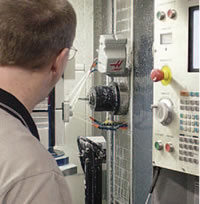
In most shops, cleaning a sump means draining the old coolant, shoveling out the chips, and recharging with fresh coolant. To properly manage your coolant, your cleanout should include running a cleaner throughout the machine, dislodging sludge and removing biological residues. The cleaning process is an essential first step in the practice of coolant management, insuring that your coolant has a fair chance at giving maximum performance with minimal problems.
Once you have decided to chemically clean your sumps, chose a cleaner that is specially designated for this job. It is important to note that you should not use floor cleaners, bleach, or hand cleaners to clean your sump. A worthy sump cleaner should possess disinfecting properties, corrosion inhibitors and foam control. Your coolant vendor should be able to provide detailed information on their recommended cleaning approach.
There is a proper method to chemically clean a sump, however. Unfortunately, it takes a great deal of commitment to carry out all the steps involved. Virtually all coolant suppliers will recommend several steps of cleaning and rinsing to produce the best result. Review the 10 Step Sump Cleaning procedure, below.
The answer is yes; you can skip some steps. However, that depends on how often you clean your sump and how contaminated the system is to begin with.
Sometimes production demands and manpower availability will force you to compromise. When this is necessary, there are alternatives. Try to incorporate as many steps as possible into the alternative methods.
During Shutdown - If you have a shutdown period, add sump cleaner directly to the dirty coolant in the machine reservoir or the central sump. It is recommended that you add the cleaner at 4%–5% concentration.
Circulate the mixture for 4 hours (or longer) through all the machines and lines. Drain, rinse and recharge your machine with new coolant. In some cases, the rinse cycle can be skipped if you can drain the sump of all liquids.
During Production - Add the cleaner directly to the coolant while production continues. This is not an ideal approach to sump cleaning and should be monitored carefully to avoid undue operator exposure. Add the sump cleaner at 1%–2%, circulate for 4–8 hours, drain, rinse and recharge.
Chemical cleaning may not achieve the desired results. With deposits of chips, swarf, mold and fungus, physical agitation of the metal surfaces may be needed to free the contaminants.
On smaller sumps, a simple cleaning brush can be used to break up deposits. For multiple machines and central sumps, a power washer with heated solutions can save a lot of time and effort.
If you have heavy biological contamination, it is highly recommended that you carry out the complete cleaning cycle. It will pay dividends.
If you cannot do a complete rinse, use a hose to rinse down surfaces as you drain the sump. Watch out for rinse water on machines however, as it can cause rust. Spray all surfaces with coolant as soon as possible to provide rust prevention.
|
ETNA Products 16824 Park Circle Drive, Chagrin Falls, Ohio 44023 Phone: 800-229-3862 / 440-543-9845 Fax: 440-543-1789 Copyright ©2025 ETNA Products, Inc. KOOLRite and SynMAX are trademarks of ETNA Products, Inc. |